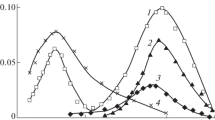Summary
Alcohol-water solutions of 3-indoleacetonitrile were exposed to ultraviolet light for different time intervals. The products of the auxin destruction were separated on paper chromatograms and tested biologically. Indoleacetonitrile was found to be partially destroyed with ultraviolet radiation. The rate of the auxin destruction increased with the time of illumination. However after 27 hours of illumination the auxin was not completely destroyed. Among the products of the auxin destruction, indole-3-carboxylic acid was identified.
Similar content being viewed by others
Literatur
Bentley, J. A., andS. Housley: Biological activities of 3-indolylacetaldehyde and 3-indolylacetonitrile. J. of Exper. Bot.3, 393 (1952).
Brauner, L.: Über pH-Veränderungen bei der Photolyse des Heteroauxins. Naturwiss.39, 282 (1952).
—: Untersuchungen über die Photolyse des Heteroauxins. Z. f. Bot.41, 291 (1953).
Gordon, S. A., andR. P. Weber: Colorimetric estimation of indoleacetic acid. Plant Physiol.26, 192 (1951).
Denffer, D. v., u.A. Fischer: Papierchromatographischer Nachweis des ß-Indolaldehyds in photolytisch zersetzter Indolessigsäure-Lösung. Naturwiss.39, 549 (1952).
Fischer, A.: Über die papierchromatographische und papierelektrophoretische Trennung von Indolderivaten. Planta (Berl.)43, 288 (1954).
Jones, E. R. H., H. B. Henbest, G. F. Smith andJ. A. Bentley: 3-Indolylacetonitrile: a naturally occuring plant growth hormone. Nature (Lond.)169, 485 (1952).
Kefford, N. P.: The growth substances separated from plant extracts by chromatography. J. of Exper. Bot.6, 129 (1955).
Kiermayer, O.: Eine einfache Arbeitsweise für den Koleoptilzylindertest. Planta (Berl.)47, 527 (1956).
Linser, H., u.O. Kiermayer: Chemische Konstitution und Zellstreckungswirkung verschiedener Stoffe. II. Mh. Chem.87, 708 (1956).
—: Fluoreszenzanalytischer Nachweis von Indolkörpern insbesondere Indol-3-acetonitril auf Papierchromatogrammen. Biochim. et Biophysica Acta21, 382 (1956).
Linser, H., H. Mayr u.F. Maschek: Papierchromatographie von zellstreckend wirksamen Indolkörpern ausBrassica-Arten. Planta (Berl.)44, 103 (1954).
Mayr, H.: Zur Photolyse von Indol-3-essigsäure bei papierchromatographischen Arbeiten. Planta (Berl.)46, 512 (1956).
Stowe, B. B., andK. V. Thimann: The paper chromatography of indole compounds and some indolecontaining auxins of plant tissues. Arch. of Biochem. a. Biophysics51, 499 (1954).
Vlitos, A. J., andW. Meudt: The role of auxin in plant flowering I. A quantitative method based on paper chromatography for the determination of indole compounds and of 3-indoleacetic acid in plant tissues. Contrib. Boyce Thompson Inst.17, 197 (1953).
Author information
Authors and Affiliations
Additional information
Mit 1 Textabbildung
Rights and permissions
About this article
Cite this article
Youssef, E., Kiermayer, O. Zur photolyse von Indol-3-acetonitril. Planta 49, 607–611 (1957). https://doi.org/10.1007/BF01911994
Received:
Issue Date:
DOI: https://doi.org/10.1007/BF01911994



